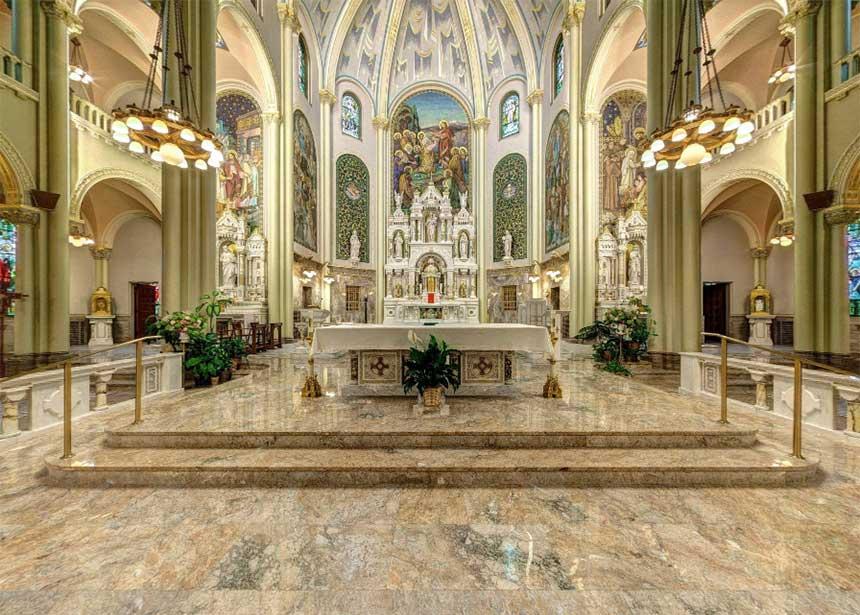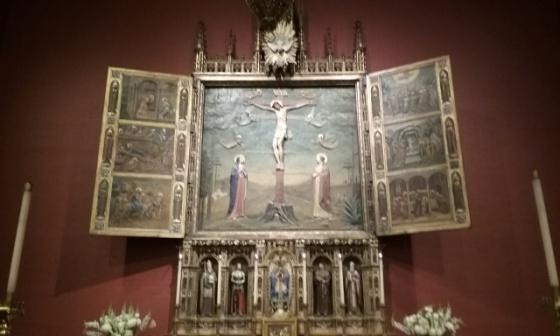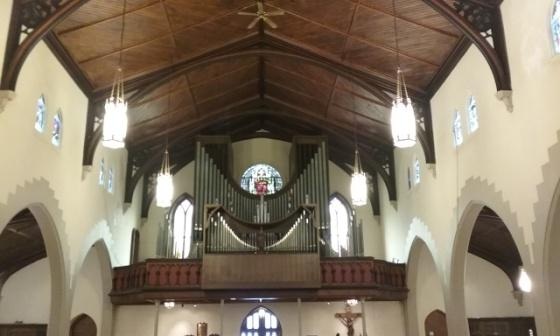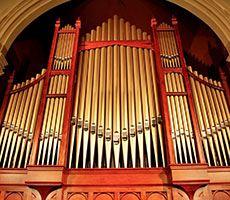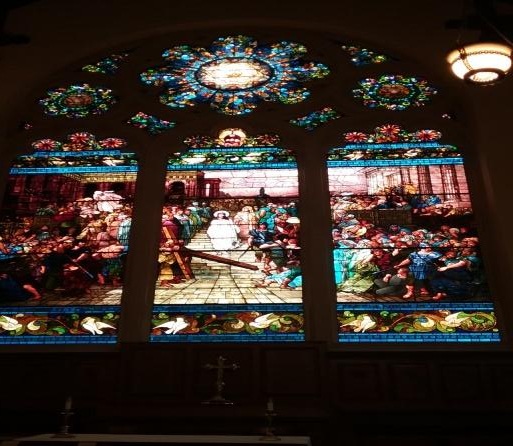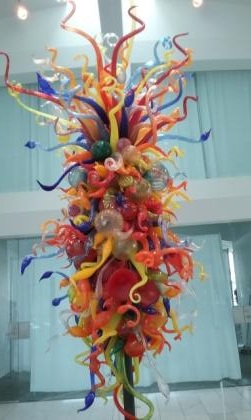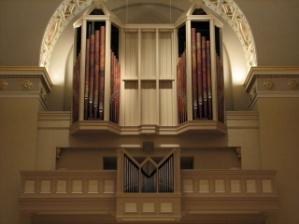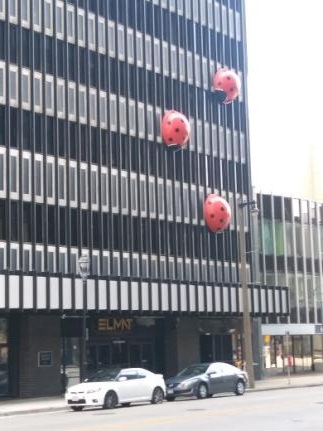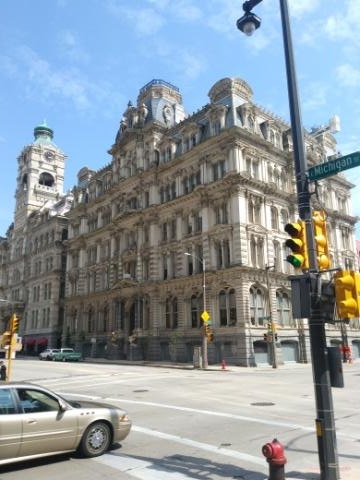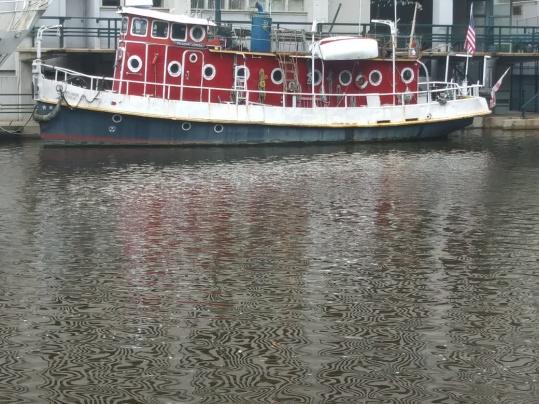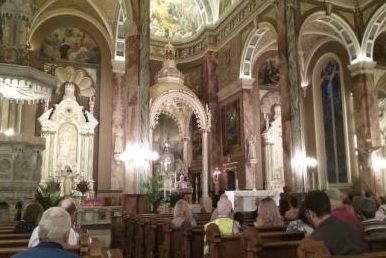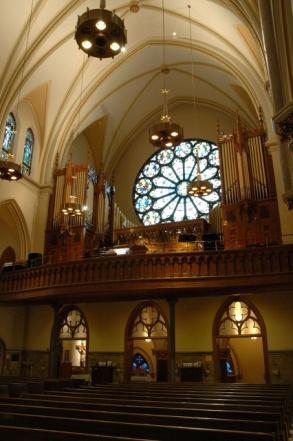The Chiff Chat in PDF format.
Chiff Chat April 2023
The Chiff Chat in PDF format.
Chiff Chat March 2023
The Chiff Chat in PDF format.
Chiff Chat February 2023
The Chiff Chat in PDF format.
Chiff Chat December 2022
The Chiff Chat in PDF format.
Chiff Chat November 2022
The Chiff Chat in PDF format.
Chiff Chat October 2022
The Chiff Chat in PDF format.
Chiff Chat September 2022
The Chiff Chat in PDF format.
Lincoln-Wichita AGO RCYO Winner
Congratulations to the winner of the 2021 Lincoln-Wichita AGO Chapters' competition of the RCYO (Regional Young Organists' Competition), Aidan Hill.
Aidan Hill is a sophomore undergraduate at the University of Kansas majoring in music with an emphasis in Organ Performance studying under the direction of Dr. James Higdon. Aidan began piano lessons in 2nd grade with his hometown piano teacher, Joan Robinson, and began organ lessons in 5th grade with Carole Pracht, organist at St. Mary's Cathedral in Wichita. Alongside his performance, Aidan enjoys writing his own original scores both for organ and piano, which include his recently completed Missa Sancta Familia for organ and choir to be used at his and his fiancée's wedding this fall.
Judges were Dr. Christopher Marks, Dr. Chelsea Vaught, and David von Behren. The committee included Ralph Phillips, Wichita AGO coordinator and Brent Shaw, Lincoln AGO coordinator.
AGO Members and Students Recital
An organ recital featuring members of the AGO and students was held at First United Methodist Church in Lincoln December 6, 2020. A video recording of the recital is on Facebook. Below is a list of performers.
- Ermal Collister played Lo, How a Rose E'er Blooming.
- Nik Barger played O God, Beyond Praising, Be Thou My Vision, and Fanfare by N. Barger.
- Ross Mosier played Fantasia in G minor by Johann Sebastian Bach.
- Jovan Cross played Ancient Galleries by Dennis Janzer.
- Jacob Kasaok played Nun Komm der Heiden Heiland by Johann Sebastian Bach.
- David Schmidt played Elegy by George Thalben-Ball.
- David Campbell played Toccata from Suite Gothique by Leon Boelmann.
- Dan Ahlin played
- Veni, Veni Emmanuel by Flor Peters
- Rorate Caeli (from Chorales on Gregorian Themes) by Jeanne Demessieux
- Hymn (from Four Pieces, Op. 71) by Flor Peeters, performed In Memoriam of Dr. Theodore Marier, M.A., FAGO
- Bill McClung played Silent Night arranged by Dale Wood.
- Sister Mary Chiara played Al' Offertorio by Domenico Zipoli.
- Brent Shaw played Meditation on Silent Night arranged by Jason Payne.
Greetings from Dean Brent Shaw
Dear friends and members of the Lincoln Chapter of the American Guild of Organists,
What an unusual time we live in! I am so thankful for AGO and each one of you doing so much work to help us find ways to stay connected, to worship, and to make music, even when we can't be together physically in ways we used to. Our amazing dean, Colt Ballou, is stepping down after a long tenure leading our chapter. Colt has recently had exciting family news he may want to share later and has taken on additional responsibilities at his church. We are all so thankful for the amazing work he has done and the legacy of Sara Schott before him.
Our wonderful subdean, Mark Miller, who does such amazing work with the treasures we have in our Lincoln Organ Showcase and the Bedient Pipe Organ Company, has asked if I would work with him by stepping up as Dean at this unusual and pivotal time in our history. I am looking forward to continuing working with him and our other wonderful board members during this time of being more "socially distant."
Thank you to members making these things possible!
Directory
A new directory will be available soon thanks to the work of Nancy Anderson and others.
Scholarships
We have been entrusted with the generous gift of an amount of money to benefit students. We will get two scholarships established as soon as possible that will help benefit not only current students, including those at college, but also rural community pianists looking to take organ. What a gift that we as a chapter can ensure music can continue in the communities and churches in so much of our state. Thanks to the work of members Sinda Dux, Ryan Luckey, Laura Ross, Dr. Jeffrey Blersch, Lily Spader and others who have offered insight and helped things get going with this.
Composition Competition
Thanks to Ross Mosier who organized students and organists to join in the process of creating new music last year. Due to COVID-19 the process and final recital had to be cancelled. He is working to get some of this going again and inviting others to join in. We hope that the final pieces could be livestreamed.
Livestream program from UNL professor Dr. Marques Garrett
Members of our chapter have donated to the Omaha AGO's online program with Dr. Garrett and the Omaha chapter has graciously invited our chapter to promote the event as "shared" or "co-sponsored." I am thankful for the amazing work the Omaha chapter has done on this. What a gift to hear from a Lincoln musician in our community who does so much at the University and who is also an active church musician and published organ composer.
Newsletters and other publications
You will receive another Nebraska Organ Happenings shortly that I've enjoyed working on as a personal project. In addition to that, and the directory, I would like to have an email newsletter put together and sent out perhaps every other month when fewer in-person events are happening. All members are always welcome to submit anything for a newsletter or for a Nebraska Organ Happenings.
When I look over our membership and community, I see multiple volunteers playing organ and piano for chapel services every week for at least three nursing homes/assisted living locations. I see retired and active music professors. I see at least two churches that have called me working on ways to celebrate their organ renovation projects even during times like this. I see people who say "I'm not an organist" but they faithfully play the few hymns they know by ear at their churches each and every week. I see so many organists frustrated and disappointed and not being able to lead the faithful in singing in-person at their churches but finding strength to find new ways of sharing music online. I see organists accompanying chants of psalms, hymns, and jazz music, and using Hammond organs, or a keyboard for an outside communion service while they wait to return to the sanctuary. I called each of you at the beginning of the pandemic and plan on doing that again and will look forward to saying "hello" and hearing any ideas you might have for us.
Thank you for making our community a better place and for sharing a love of music and the organ.
2020–2021 Executive Committee
Dean, Brent Shaw (organman77 (at) gmail (dot) com)
Subdean and LOS Chair, Mark Miller
Treasurer, Ryan Luckey
Secretary, Sinda Dux
Directory Chair, Nancy Anderson
Chaplain, Fr. Troy Schweiger
Priscilla Kliewer
Brian Lew
Ross Mosier
Lily Spader
David Schmidt
2019 Great Lakes AGO Regional Convention
Jim Hejduk reports on the Great Lakes AGO Regional Convention in Grand Rapids, MI, June 30–July 3.
Two summers ago, I opted to attend the Great Lakes AGO Regional Convention in Youngstown, OH because I was impressed by the lineup of artists and it afforded me an opportunity to visit my family. This year, I chose to go to Grand Rapids for exactly the same reasons. Too, I'd never been to Grand Rapids and a Westminster Choir College buddy, Larry Biser, was the program chair so I wanted to support him. Grand Rapids is larger than Lincoln and there's definitely a Dutch Reformed influence there. Moreover, for a city its size, Grand Rapids boasts a striking number of out-sized instruments. 4- and 5-manual instruments were not uncommon in several churches there.
We began with a Sunday afternoon evensong service with a pre-service recital by Nicole Keller from Cleveland playing Trinity Lutheran Church's III/37 Letourneau. The organ sits prominently on the left side in the front of the church. Its voicing and the church's lively acoustics offer it plenty of punch.
Voluntary for Organ—William Bolcom
Partita: Jesu, meine Freude—Johann Walther
So Fades the Lovely Blooming Flower—George Shearing
A Quaker Reader—Ned Rorem
- A Secret Power
- The World of Silence
- There is a Spirit that Delights to do no Evil
Jig for the feet (Totentanz) from Organbook III—William Albright
Keller's playing was assured and used the organ to maximum advantage. It was a blissful marriage of instrument and repertoire.
The service itself was veddy British indeed. Conductor Scott Bosscher was a former choral scholar at Wells Cathedral and the Grand Rapids Choir of Men and Boys is the only RSCM choir in Michigan not affiliated with a church or school. This all-volunteer group is quite extraordinary. The music included Introit I—Let the People Praise Thee, O God by William Mathias as well as settings of the chanted Preces and Psalms by Philip Radcliffe, H. Walford Davies, and H. G. Ley while the "Mag" and "Nunc" settings were by Stanford (in B-Flat). The service was interspersed with Biblical readings as well as poetry, the Creed, etc. plus a short sermon (something one does not have to usually endure in British services!). The musical centerpiece of the service was Finzi's Lo, the Full, Final Sacrifice followed by Philip Stopford's In My Father's House sung in memory of a young chorister who had died in a car crash at the beginning of this season. C.H.H. Parry's setting of O Praise Ye the Lord (in the Willcocks arrangement) was sung mightily by the congregation at the conclusion of the service. I would add that organist Kenneth Bos accompanied this service with stunning aplomb given the instrument on which he had to play (hardly rife with mellow, enveloping diapasons and celestes). Nicole Keller returned to the bench to play Stanford's Allegro from his Six Short Pieces, Op. 108 for the appreciative conventioneers. This was a glorious slice of England in Grand Rapids. The choir is obviously well-trained and hard-working. The boys don't quite have the "zing" in their high notes like English choristers, but they've obviously bought in to the mystique and no little magic that their conductor seeks to instill in each of them through this glorious choral tradition.
Sunday evening featured Scott Dettra (son of one of my Choir College dorm floor mates) and the Majestic Brass of Grand Rapids at Central Reformed Church (Schantz, 1957/Robert Dial, 1982—V/80). Dettra is truly an accomplished pro and the brass ensemble was on a par with our own Plymouth Brass.
Sinfonia Festiva—Daniel Gawthrop
Fantasia on the theme of Hindemith (organ solo)—James D'Angelo
Concerto for Brass, Organ, and Percussion—Robert Elmore
Salve fac populum tuum—Charles-Marie Widor
Arioso (organ solo)—Leo Sowerby
Suite for Organ, Brass Quintet and Percussion—Craig Phillips
This was a program with something for everyone (except for folks who might have preferred more organ solo music perhaps) and was masterfully played. It was wise, indeed, to feature Grand Rapids groups (with guest organists) to perform at the opening events so local musicians could really "strut their stuff." Many came away impressed by just what Grand Rapids has to offer musically.
Monday morning's Festival Worship Service at St. Adelbert's Roman Catholic Cathedral (Wicks, 1980, III/72—but the glorious acoustics caused many to suppress their skepticism) continued with impressive local talent. Program Chair Larry Biser assembled a pickup Convention Festival Chorale and organist Jonathan Tuuk (who played at the "old" St. Mark's Methodist on our LOS series decades ago) served stunningly as soloist and accompanist. Tuuk began with the Franck B Minor Choral and the choral introit was Locus Iste by Bruckner. Other anthems during the service included I Was Glad by Parry, Howard Hanson's setting of Psalm 8 and the Gloria from Argento's The Masque of Angels. The hymns during the service included Thaxted (aka Jupiter from The Planets by Holst), Nettleton, and Lauda Anima with an eye-opening new text by Larry Biser. The thoughtful address was delivered by Dr. Don Saliers, AGO National Chaplain (with whom I sat on the bus returning from the previous afternoon's service). Jonathan Tuuk concluded the service with a scrupulous yet searing account of the Tournemire-Durufle improvisation on Victimae Paschali Laudes. Though retired, Tuuk has organ chops to spare, believe me! His accompaniments (anthems, hymns, etc.) throughout were spot-on, sure-handed, and tasteful.
Beginning the day with an address by the National Chaplain, the concept of national continued throughout Monday by nationally (and internationally) acclaimed artists. In the early afternoon, we heard Katelyn Emerson at Grace Episcopal Church (Noack, III/53), the home parish of Gerald and Betty Ford.
Prelude and Fugue in G Major, BWV 541—J. S. Bach
Ballo del Granduca—Jan Sweelinck
Ich ruf' zu dir—Vincent Lubeck (an extended setting I'd never heard before)
Fantasie et fugue en si bemol majeur—Alexandre Pierre Francois Boely
Variations sur un theme de Clement Jannequin—Jehan Alain
Sechs Fugen über den Namen BACH—V. Lebhaft
Choral in A Minor—Cesar Franck
I've heard Emerson at St. Cecilia's in Omaha and at First Presbyterian in Kilgore, TX and found her playing quite stunning and deeply mature for one so young. She maintained that impression here, though I would have advised against playing the Franck as a closer given this particular instrument and its tuning. But the other pieces were abundantly well-suited to the Noack and stylishly rendered.
Then it was back downtown to hear Gregory Crowell (another more recent LOS performer on a variety of instruments at First Christian Church) at Central Seventh Day Adventist Church on an 1893 Johnson & Son instrument, 11/17. The church's membership has shrunk markedly over the years so little has been done to maintain, let alone enhance the interior of the (un-air-conditioned) interior or the organ. But this isn't necessarily a bad thing. The jewel-like interior with its richly decorated wooden arches and lovely stained glass windows and the organ itself are in remarkably pristine condition and Crowell's program was beautifully suited to this unique gem of an instrument.
Vergnügte Ruh'—J. S. Bach, arr. Brigitte Dubiel
Vesper Voluntaries—Edward Elgar
- V. Poco Lento
- VII. Allegretto pensoso
Praeludium in F-Sharp Minor—Ernst Friedrich Richter
Fugue in C Major—Charles Zeuner
Two Character Pieces—James Woodman
- Wardie's Dump (and Crowell finally explained just what a "Dump" is musically speaking!)
- Gagliarda for Emily and Kip
Abendlied—Robert Schumann, arr. Karg-Elert
II. Lebhaft from Sechs Fugen über den Namen BACH—Robert Schumann
Meditation—Arthur Foote
Toccata, Op. 71 No. 7— Arthur Foote
OK, let's be honest. How many of those pieces have you ever heard before, let alone played? This was a monument to deep study and exacting detail in an effort to find works appropriate for this unique period instrument at which Crowell succeeded triumphantly with attentive, hand-fanning listeners soon ignoring the sweltering heat in tribute to that Herculean effort and the success it wrought.
Then we literally walked next door to LaGrave Avenue Christian Church. From what I could discern, the more generously supported LaGrave Avenue church has taken the SDA congregation under its wing, enveloping it in its campus, and helps keep it afloat. We eagerly poured into the large air-conditioned sanctuary to hear Todd Wilson play the V/77-32 Digital Austin/Allen hybrid organ. When Todd Wilson plays, you just know nothing will go wrong (unless the organ misbehaves—and this one didn't). His programs are always memorized, monumental, and memorable. We heard him masterfully perform
Sonata on the 94th Psalm—Julius Reubke
Three Cincinnati Improvisations—Gerre Hancock, transcribed by Todd Wilson
- Lobe den Herren
- Grand Isle
- Ar Hyd Y Nos
Suite, Op. 5—Maurice Durufle
Yeah; in a word "Wow!"
Having barely recovered from that recital, a few workshops, and dinner, we departed for Fountain Street Church (U-U) that evening to hear Ken Cowan on the V/138-34 Digital Austin-Allen in this storied edifice. I knew students from my era who had studied at this fabled church with Beverly Howerton, its esteemed Director of Music. (Its renowned minister at that time was Rev. Duncan Littlefair—sometimes referred to as "Drunken Littlefaith."). An even more recent LOS performer (First Presbyterian), Cowan provided us with one of his all-memorized extravaganzas.
Overture to Der Fliegende Holländer—Richard Wagner, arr. E. H. Lemare (also his LOS opener)
Pastorale—Roger-Ducasse
Humoresque (Homage a Marcel Dupre)—Rachel Laurin (another LOS selection)
Chromatic Fantasia and Fugue in D Minor—J. S. Bach, arr. Max Reger
L'Envoi—George Baker
Valse Mignon—Sigfrid Karg-Elert
Deuxieme Symphony—Marcel Dupre
So on this Monday alone, we had an address by the National Chaplain, three recitals by national icons, and a jewel box program on a blessedly untouched gem by a prominent local artist. Grand Rapids was truly pulling out all the stops for us!
Tuesday we were off to Holland which, yes, has lots of Dutch-inspired architecture, a tulip festival, and downtown sidewalks which are heated in winter to prevent icing over and resultant slippage! This is one very progressive, prosperous, and performance-friendly town on the shores of Lake Michigan, by golly! Our first program was at Grace Episcopal Church on a stunning 2016 Martin Pasi instrument, II/19, ideally located in a rear apse for maximum exposure and projection. Rhonda Sider Edgington (who we'd also heard in Youngstown) had played the dedication recital on this organ and knew it like the back (and front) of her hand. She craftily alternated older repertoire with modern pieces to show this remarkably versatile organ at its best (and distributed wonderfully illuminating program notes as well).
Praeludium in F Major, Bux 145—Dieterich Buxtehude
Three fugues from Twelve Short Pieces for Organ, Op. 43 - Rachel Laurin
- Fugue Cirulaire
- Fugue Triangulaire
- Fugue Carree
Concerto in A Minor—Vivaldi/J.S. Bach
Church Bells Beyond the Stars—Cecilia McDowall
Three chorale preludes—Georg Böhm
- Christ lag in Todesbanden
- Vater unser im Himmelreich
- Christum wir sollen loben schon
Prelude, Aria, and Finale—Margaret Vardell Sandresky (whose works I first heard at the Los Angeles National Convention way back when).
There was a program of handbell music given by Larry and Carla Sue (a husband-and-wife team who met online on The Handbell Community web site!) at Third Reformed Church and then it was off to Dimment Memorial Chapel on the Hope College campus to hear David Heinze who this month has taken up the post of Associate Director of Music at Grace Episcopal Church in Providence, RI. He's an alumnus of Hope and the Interlochen Arts Academy and has also had extensive training and experience in Great Britain. He played the chapel's vintage E. M. Skinner IV/48 for us in appropriately selected works.
Marche Hongroise from La Damnation de Faust—Berlioz, arr. Henri Busser
Solemn Melody—Henry Walford-Davies
Symphonie Romaine, Op. 72—Charles-Marie Widor (marking the 175th anniversary of his birth)
Armed with box lunches, we headed off to various workshops or the lakeside Holland State Park before returning to the Hope campus's stunning Jack H. Miller Center for Musical Arts (Eat your heart out, Westbrook!) with its jaw-dropping recital hall and 2015 Casavant III/54. The donor of the organ was in attendance and recognized. His donation stipulations were that the organ had to be a Casavant and that the pipes were not to be visible! So the pipes are at the rear of the large stage behind a cloth screen and handsome wood framing. Huw Lewis, long-time Hope College organ professor played
Partita: Sei gegrüßet, Jesu gütig, BWV 768—J.S. Bach
Symphonie I—Louis Vierne
These contrasting works showcased the organ's versatility and Lewis's virtuosity and musicality. Following this program, Lewis led a scintillating and insightful masterclass.
Then it was back to Grand Rapids, a speedy supper, and Lynne Davis's concert at the Cathedral of St. Andrew which sports a rear gallery 2002 Letourneau, IV/54. Interestingly, this all-French program was performed on a French-Canadian instrument whose specifications use German nomenclature (except for the older front chancel organ with a II/18 disposition). This posed no problems for Davis, accustomed to the Marcussen instrument at Wichita State U. in Kansas.
Te Deum—Jeanne Demessieux
Livre d'Orgue—Pierre DuMage
- Plein Jeu
- Tierce en Taille
- Basse de Trompette
- Dialogue sur les Grands Jeux
Choral I—Cesar Franck
Pieces de Fantasie—Louis Vierne
- Andantino
- Toccata
Intermezzo—Jehan Alain
Litanies— Jehan Alain
II. Moderato cantabile from Symphonie No. 8—Charles-Marie Widor
Variations de Concert—Joseph Bonnet
I'm accustomed to hearing Davis play the big French potboilers, so was surprisingly impressed with her DuMage for which she seemed to have a very capable and studied affinity.
We relished the late start offered Wednesday after two very busy days and began with a presentation by Clark Wilson on the mighty Wurlitzer installed at the Grand Rapids Public Museum. This new-ish structure isn't an art museum per se but, rather, something akin to a grand and very imaginative children's and science museum whose exhibits were visually and educationally appealing and to which youngsters were drawn enthusiastically. And its second-floor auditorium has a uniquely installed Wurlizter III/29 dating from 1928 and updated by G.M. Buck Pipe Organs in 1994. Wilson gave a great demonstration of the instrument and its capabilities, then favored us with a colorful and creative medley of Judy Garland hits (I'd forgotten there were so many) followed by an accompaniment to an early Laurel and Hardy silent film. We then went a few blocks to the campus of Grand Valley State University to hear a carillon recital on the Beckering Family Carillon of 48 bells cast by Fonderie Paccard by Helen Hofmeister, a former Grand Rapids AGO Dean and principal organist and choir director of Westminster Presbyterian Church there. The weather was breezy for pleasant outdoor listening or one could listen from inside while enjoying selections from the food court. Her program was stunningly varied and frankly left me pleasantly surprised at my level of attention and enjoyment.
Leyenda—Isaac Albeniz, arr. Albert Gerken
A Suite of English Folk Songs—Ronald Barnes (a name I recognized from his Washington Cathedral days)
- The Lark in the Morn
- The Keys of Canterbury
- O Sally My Dear
- Driving Away at the Smoothing Iron (something I suspect has nothing to do with golf!)
Chartres—Roy Hamlin Johnson
Chessie 'Round the Mountain
American Music—arr. Milford Myhre
- America the Beautiful (Samuel Ward)
- Simple Gifts (Shaker Hymn)
- Jeanie with the Light Brown Hair (Stephen Foster)
- Beautiful Dreamer (Foster)
Suite III for Carillon—Henk Badings
- Preludium
- Passacaglia
Then it was off to Immanuel Lutheran Church (Schlicker, 1963—Lauck Pipe Organ Co. 1976–2004, III/56) to hear Noah Klein, a Northfield, MN native who studies with Janette Fishell at Indiana University, play his winner's recital as part of the Quimby Regional Competition.
Hymn: Lasst uns erfreuen
Piece Heroique—Cesar Franck
Prelude and Fugue in A Minor, BWV 543—J. S. Bach
From Five Dances for Organ—Calvin Hampton
- At the Ballet
- Those Americans
Final from Symphony I—Louis Vierne
This was not a sympathetic room acoustically and Klein's playing was marked more by speed than musicality. I suspect his win was a result of disparate opinions by the judges resulting in a compromise. He's by no means untalented and will undoubtedly develop into a much more mature player.
We then proceeded to storied St. Mark's Episcopal Church where Gregory Crowell holds forth. Leo Sowerby was a choir boy here and Paul Callaway was St. Mark's organist before going to the Washington National Cathedral. We heard Nicole Simental, Assistant Director of Music and Principal Organist at St. Joseph Cathedral in Columbus, OH who is also a DMA candidate at Indiana U. with Christopher Young. She received her Masters in Sacred Music at Notre Dame with Craig Cramer and Delbert Disselhorst (possibly a contemporary of Michael Emmerich's there?). The organ is a J. W. Walker, 1V/69 dating from 2004.
Tierces from Four Concert Etudes—David Briggs
Variations on Est-ce Mars—J. P. Sweelinck
Prelude and Fugue in E Minor, BWV 548—J.S. Bach
Lullaby (Suite #2)—Calvin Hampton
Sonata IV in B-Flat Major—Felix Mendelssohn
II. Andante Sostenuto from Symphonie Gothique—Charles-Marie Widor
I. Allegro from Symphonie No. 2—Louis Vierne
This was a big program but Simental flew through it in nothing flat. After her stunning opener which gave us plenty of assurance of her technique, the rest was noteworthy mainly for its speed. The Widor provided a glimpse of what she may be capable of musically, but the rest of the pieces were marked mainly for their breakneck tempos. Maybe she had a plane to catch back to Columbus. Who knows?
That evening's closing recital was by Nathan Laube on the V/94 1968 Tellers at Mayflower Congregational Church, later updated by Lauck Pipe Organ Company in 1998. This large American colonial edifice looked as if it had been uprooted from New England and had been Jonathan Tuuk's final Grand Rapids 26-year position prior to his retirement. Laube's printed program was full of enticements like his transcription of the Liszt B minor piano sonata and Hungarian Rock-Chaconne by Gyorgy Ligeti which I was anxious to hear. However, Laube had undergone surgery on his left foot and his cast had been removed only ten days prior to this concert. This necessitated a change in program which retained some pieces, discarded others, and plugged in new ones. But what we ended up with was by no means disappointing in the least!
Sonata Eroica—Joseph Jongen
Passacaglia in C Minor—J.S. Bach
Variations Serieuses, Op. 54—Felix Mendelssohn, transcribed by Laube
Overture to Tannhäuser—Richard Wagner, transcribed by S. P Warren, E. H. Lemare, N. J. Laube
Most of the cheering, wildly clapping attendees left the sanctuary stunned, slack-jawed, and vowing either to practice much harder or give up the organ altogether. It was simply dazzling on all fronts in terms of technique, musicianship, and audience appeal. One cannot imagine a more brilliant finish.
From the stylish and cleverly designed utilitarian tote bags to the generous, spiral-bound program book to the kill-'em-with-kindness and literal door-to-door bus service, the stylish hotel (with two Wolfgang Puck eateries, a Ruth's Chris, and a Starbucks), an over-the-top, mouth-watering banquet in the gorgeous hotel ballroom and "whatever it takes" chapter helpers and enablers, this was one well-oiled machine of a convention with a star-spangled array of performers. Hats off to Grand Rapids! Add a $325 registration fee which included bus transportation and the banquet and Grand Rapids will be hard to top anywhere!
And how nice to chat a number of times with Laura Hedstrom, our local competition winner and Concordia alumna who's now thriving in her church position in Elkhart, IN as well as James Brown, an old Boston buddy who's been at St. Giles Episcopal in Northbrook, IL as well as Northern Illinois University in DeKalb for longer now than either of us would care to remember!
2019 North Central Regional AGO Convention
Sinda Dux reports on the 2019 North Central Regional AGO Convention in Milwaukee June 16–19.
"A Great City on a Great Lake for some Great Music." It may be a long title but it certainly sums up Milwaukee, Wisconsin during June 16–19, 2019 for the North Central Regional AGO Convention. I had a wonderful time, listening to fabulous organists on marvelous organs, exploring Milwaukee for the first time, and, of course, talking to old and new friends.
The Convention began with a great concert by Jan Kraybill of Kansas City, who has played here in Lincoln several times. Her concert, "A Community of Voices," absolutely wowed the crowd with selections by J. S. Bach, Liszt, Tournemire, and Dupré, among others. The organ is a 1981 Casavant Opus 3493 3/35. St. Joseph's Convent Chapel is a stunning Romanesque Revival building with marble imported from 15 locations around the world and 115 stained glass windows from Innsbruck, Austria.
Monday began with Morning Prayer at All Saints' Episcopal Cathedral led by the Cathedral Choir, whose music ministry is offered twice weekly. The original organ was renovated in 1999 by the Schlicker Organ Company of Buffalo, New York. The 3-manual instrument, with added stops and ranks, was dedicated in 2002.
This Morning Prayer service was the first time I had ever sung The Lord's Prayer and The Apostles' Creed, each on one note. We also chanted a Venite, Te Deum, Suffrages, and Collects—a very interesting "high church" experience for me.
Three music companies, Hall Leonard, Cliff Hill Music, and MorningStar, presented music for the choral reading sessions which were enthusiastically received by the participants. It helps to have excellent accompanists!
After a box lunch, it was "back on the buses" to St. Paul's Episcopal Church to hear the winner of the RCYO Competition, which had taken place the previous Sunday afternoon. The winner and two runners-up were introduced and received enthusiastic applause. Winner Michael Terry Caraher is a junior at St. Olaf College in Northfield, Minnesota and an organ student of Dr. Catherine Rodland and voice student of Dr. Anton Armstrong.
His program was played on a Schantz 3-manual Opus 2307, 2011, with pipework by Hook and Hastings Opus 1187 from 1884, rebuilt in 1951 and 1970. Michael played Prelude and Fugue in C Minor, BWV 546, by J. S. Bach; The Resurrection by Larry King (my personal favorite); Musica Dominicalis: Moto Ostinato by Petr Even; and Piéce Héroĭque by Franck, all played wonderfully and earning Michael a standing ovation.
I loved this church because it contains original stained glass windows signed by Louis Comfort Tiffany. One such window is called Christ Leaving the Praetorium and is the largest stained glass window Tiffany ever made: 30 feet long, 24 feet high, and 2 inches thick.
Three excursions were offered for the afternoon: the Milwaukee Art Museum, the Harley-Davidson Museum, and Lakefront Brewery. I know some of you will be disappointed to read that I chose the most cultural of the choices, the Art Museum. I was told that several of those who went to the Brewery came back to the hotel with throbbing heads after tasting too many samples!
After dinner on our own and enjoying the exhibits, we boarded the buses for St. John the Evangelist Church, mother church of the Catholic Archdiocese of Milwaukee. Michael Hey, the concert organist, graduated in 2014 from the accelerated five-year degree program at The Juilliard School, receiving both his Bachelor of Music and Master of Music degrees in Organ Performance under Paul Jacobs. Since 2015 Michael has been the Associate Director of Music and Organist of St. Patrick's Cathedral in New York City where one of his first major tasks was to perform for the first U.S. visit of Pope Francis. No pressure!
Michael's program for the convention, played on a 2005 Nichols and Simpson 3-manual organ, included Widor, Ravel, Dudley Buck, Seth Bingham, Jonathan Dove, and Leo Sowerby.
And so to bed, to coin a phrase.
Tuesday I skipped the morning workshops and afternoon concerts and did a walking tour of downtown Milwaukee, seeing the original Pabst Brewery and Pabst Mansion, many Romanesque Revival, Greek Revival, and (my favorite) Art Deco beautifully preserved buildings, and a bit of the River Walk. I also went back to the Milwaukee Art Museum.
I rode a city bus to the evening convention supper, a fish fry in an ethnic Serbian neighborhood, and then to the absolutely incredible Basilica of St. Josaphat in an ethnic Polish neighborhood. As I was told, a cathedral belongs to a bishop and a basilica belongs to the Pope; the Pope has to okay the basilica and then okay the design. St. Josaphat has a very interesting history: the first building was deemed too small so the resident priest ordered that a new, larger church be built. He heard that the Post Office and Customs Building in Chicago was being torn down so he rented 500 boxcars to carry all the materials from that Chicago building to Milwaukee to build the new church. Much of the labor, unpaid of course, was by the congregation members. The cornerstone was laid in 1896 and the building finished in 1901. Even today the door knobs of the Basilica have the U.S. Treasury symbol on them from the original Chicago Post Office/Customs Building.
A most enchanting program was given by the Chant Claire (French for "clear sound") Chamber Choir; some selections were The Spheres by Ola Gheilo, Kyrie from Mass in Eb by Rheinberger, Ave Maria by both Holst and Biebl, the gorgeous Miserere Mei Deus by Allegri, a Bulgarian love song, Amazing Grace and Schenectady from The Sacred Harp, and O Day Full of Grace, arranged by F. Melius Christiansen. The reverb in that sanctuary was at least 7–10 seconds so it was a spiritual experience, certainly.
After the concert, everyone was invited to the undercroft to view the historical exhibits of the church and to play/hear the 1905 2-manual Kimball organ, restored by Buzard Pipe Organ Builders.
The last day of the convention, Wednesday, was really, really busy. It began with a regional breakfast meeting in the hotel atrium during which regional officers, chapter officers from each state in the region, and convention planners were recognized.
The Chapel of Christ Triumphant at Concordia University Wisconsin, on the shores of Lake Michigan, was the setting for the morning's Hymn Festival. I had total cognitive dissonance all through the worship. The word "Concordia" made me know that this was a Lutheran Church-Missouri Synod college; yet the Chapel contained a huge crucifix, side altars, kneelers, and large Stations of the Cross! Afterwards I found out that the college used to be a Catholic school that went bankrupt and was bought by the LCMS which apparently just decided to leave the Chapel as it was except, so I was told, that the huge stained glass window showing Christ Triumphant used to show the Assumption of Mary.
John Behnke, who has also played here in Lincoln for the Lincoln Organ Showcase, was organist accompanied by a trumpeter, The Milwaukee Handbell Ensemble, and the Festival Chorus. Marvelous arrangements of familiar hymns and the outstanding organ playing by Behnke made this event very special. The organ is a 3-manual Steiner-Reck, Opus 88, 1989.
A box lunch on the bus (not my favorite way of eating a meal) was followed by a stop at Sts. Peter & Paul Catholic Church back in Milwaukee for a recital by Jillian Gardner, a Baylor University (Waco) graduate and a member of the AGO Young Organists. She played on a 2-manual Robert Sipe organ Prelude and Fugue in E Major, BWV 566, by J. S. Bach; 3 Inventions from the School of Trio Playing by Bach/Max Reger; Fugue in G Minor by A. L. Barnes; a lovely Fountain Reverie by Percy Fletcher; Passacaglia from Sonata 8 by Rheinberger; and Jillian's own transcription of six songs from Act III of The Sleeping Beauty by Tchaikovsky.The transcription proved to be the audience favorite of Jillian's recital.
Then on to hear the Casavant Opus 2479, 2013, 3/36 at Mount Carmel Lutheran Church ELCA played by Elisa Bickers of Prairie Village, Kansas. She specializes in the organ music of Olufela Sowande (1905–1987), a Nigerian composer who moved to the United States and whose works were inspired by African folk song, Anglican traditions, and American jazz. Elisa also played Nicolaus Bruhns, Cecilia McCowall, Vierne, Grieg, and Mendelssohn.
Our buses took us back to the hotel where we could freshen up, rest, maybe change clothes, and then attend the banquet in the hotel atrium. The last event of the convention was held at the Catholic Church of the Gesu on the campus of Marquette University. Another gorgeous church sanctuary and an unbelievably beautiful and intricate concert by Lynne Davis, Professor of Organ at Wichita State University School of Music in Kansas. She spent from the late 1970's to 2006 living in France and actually became a French citizen, having married Frenchman and Chartres International Organ Competition founder Pierre Firmin-Didot. Following the immense success of the American Alain Festival, which she organized at Wichita State University to celebrate the 100th Anniversary of the birth of Jehan Alain, she was awarded as a French citizen the Chevalier de l'Order des Arts et des Lettres from the French Ministry of Culture and Communication in 2012. Lynne's selections were by Demessieux, Pierre Du Mage, Franck, Vierne, Jehan Alain, Widor, and Joseph Bonnet. The 4-manual organ is described thusly: W. W. Kimball Company, 1890's; Kilgen Organ Company, 1955; Schantz Organ Company, 2010.
The 2020 National AGO Convention will be in Atlanta, Georgia. The 2021 Regional AGO Convention will be July 4-7 in the Twin Cities of Minnesota.
2018 National AGO Convention
NWU Organ Crawl at First-Plymouth
Organ Students at First Church & NWU
A Morning with John Ferguson
The 7th Annual East Texas Pipe Organ Festival
Pedals, Pipes & Pizza!
A free program presented on Friday, Oct. 20, 5:30–7:30 pm, by the Lincoln AGO and Westminster Presbyterian Church. This is a chance for kids to meet the King of Instruments at Halloween. Here are the official flyer and the mandatory registration form.


